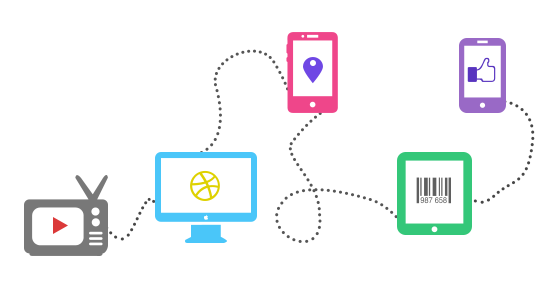
Ad attribution is one of the most challenging analytic problems in marketing today. Who saw which ads, and what purchases resulted? It’s a sticky challenge, especially in an increasingly multi-screen world. As a result, many advertisers use simplified models for attributing customer response. For example, the last click model attributes conversions to the last message a consumer saw.
But smartphone penetration and the age of big data are coming together to create an environment where deeper ad attribution is attainable. This includes the traditionally elusive area of offline ad attribution — connecting the dots between digital engagement and real world (read: local) conversions. The mobile device now provides that link (see our white paper on this topic).
The discussion surfaced again at ad:tech last week. Microsoft data scientist Lin Huang outlined the company’s keyword assist model wherein “the data drives the attribution.” In other words, there’s no pre-existing template about how attribution is assigned. Instead, Bing data (not to be confused with Big Data) determines what search terms naturally cluster together, and what activities they drive.
If a Hyatt property in Hawaii runs a display campaign, impressions resulting from a search cluster could include terms like “Hawaii vacation” or “Hawaii trips.” The attribution weighing of those terms can be measured against a subsequent search for “scuba Hawaii” that directly resulted in a click to book at the Hyatt property. So the earlier — and sometimes more influential — search can get its due credit.
Google and several others have their own flavors of full-funnel attribution. Lin Huang believes the Microsoft’s keyword assist model is “beyond parity” with Google’s latest approach, but of course his inherent bias should be noted. And his examples are mostly around e-commerce transactions, which are of course notable. But offline attribution is where it gets interesting… and very local.
This is important for any advertiser targeting local markets, given that offline is where 93 percent of U.S. commerce happens. Connecting the dots between digital and analog worlds will be the holy grail of local advertising (cue: John Wannamaker quote). And mobile is the key to unlocking that famously illusive challenge, given that it physically goes to the store with you.
So what do these offline attribution models look like? Many extrapolate by creating ad-exposed control groups and measure geographic sales lifts among those groups. There are also ways to measure ad effectiveness by linking social identity to purchase method (see Facebook/Datalogix partnership). Mobile payments will ultimately clarify the path to purchase, but we’re still very early there.
As with most new technologies, initial adoption for all of the above will be with national and brand advertisers. SMBs will adopt through agencies, media companies, and other intermediaries. We expect that SMBs with the greatest economic incentive will move first to sophisticated attribution. Think: high-consideration / high-value purchases like legal, financial, medical and automotive.
__________
Steve Marshall contributed original reporting and insights to this post

This Post Has 2 Comments
Leave a Reply
You must be logged in to post a comment.

Microsoft wasn’t the only one at ad:tech talking about online-to-offline (in-store) sales attribution. Retailigence won the CPG Spotlight competition (judged by Clorox), for a pitch around true online-to-offline SKU sales attribution with a GUARANTEE that if Clorox did not see a specific in-store sales lift, that the CEO (for open disclosure, me! ; ) would take money out of his own pocket to pay the client the difference! Retailigence believes that for the foreseeable future, it is going to be impossible to measure every shopper one-by-one and so looking at the aggregate of sales lift by SKU by store (to see all incremental sales regardless of who), versus control stores is the way to go. Big CPG and consumer electronics brands seem to agree and are jumping into this methodology. Results can be as much as 20% lift in sales, or as much as 500% ROI. The measurement can be added to any online media or campaign, on any publisher, from any Ad-Tech vendor.
Great article, just what I wanted to find.